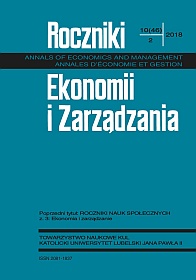The Usefulness of Econometric Methods in Research on the Shadow Economy
Abstract
The article presents the current applications of econometric methods in the analysis of gray economy. The work presents a formal framework of methodology for the study of unofficial economy and the possibilities of econometric methods in analyzes aimed at estimating the size of the shadow economy and in-depth studies of its structure and cause-and-effect relationships. In addition to indirect methods, such as the balance of electricity consumption (household electricity approach) of M. Lackó or the analysis of the currency demand method of V. Tanzi – the methodology of structural equation models, assessed as an approach with unused exploratory potential, has been widely discussed.
References
Bednarski M., Kryńska E., Pater K., Walewski M., Przyczyny pracy nierejestrowanej w Polsce, Ministerstwo Pracy i Polityki Społecznej, Warszawa 2008.
Bollen K.A., Structural Equations with Latent Variables, Wiley, New York 1989.
Breusch T., Estimating the Underground Economy using MIMIC Models, “Working Paper” (Canberra) 2005.
Breusch T., The Canadian Underground Economy: An Examination of Giles and Tedds, “Canadian Tax Journal” 53(2005), No. 2, pp. 367-391.
Cichocki S., Metody pomiaru szarej strefy, „Gospodarka Narodowa” 2006, nr 1-2, s. 37-61.
Dell’Anno R., Schneider F., Estimating the Underground Economy by Using MIMIC Models: A Response to T. Breusch’s Critique, “Working Paper” 2006, No. 0607, Department of Economics, Johannes Kepler University of Linz.
Dobozi I., Pohl G., Real Output Decline in Transition Economies – Forget GDP. Try Power Consumption Data!, “Transition Newsletter” 6(1995), No. 1-2, pp.17-18, World Bank.
Drozdowicz-Bieć M., Szara strefa w PKB, czyli liczenie niepoliczalnego, https://www.obserwatorfinansowy.pl/tematyka/makroekonomia/szara-strefa-w-pkbczyli-liczenie-niepoliczalnego/ [dostęp: 15.04.2018].
Dvorianinov A.V., Directions of Unshadowing the Economy of Ukraine Due to the Using of Tax Mechanisms, “Financial Space” 2013, No. 4, pp. 157-159.
Dybka P., Kowalczuk M., Olesinski B., Rozkrut M., Torój A., Currency Demand and MIMIC Models: Towards a Structured Hybrid Model-Based Estimation of the Shadow Economy Size, SGH KAE Working Papers Series, Warszawa 2017.
Dziennik Urzędowy Unii Europejskiej L 174 (wyd. pol.), Legislacja, t. 56, 26 czerwca 2013, https://eur-lex.europa.eu/legal-content/PL/TXT/?uri=OJ%3AL%3A2013%3A174%3ATOC [dostęp: 15.04.2018].
Feige E.L. (Ed.), The Underground Economies: Tax Evasion and Information Distortion, Cambridge University Press, Cambridge 1989.
Frey B., Weck-Hannemann H., The Hidden Economy as an “Unobservable” Variable, “European Economic Review” 26(1984), No. 1-2, pp. 33-53.
Fundowicz J., Łapiński K., Peterlik M., Wyżnikiewicz B., Szara strefa w polskiej gospodarce w 2016 roku, IBnGR, Warszawa 2016.
Giles D., Measuring the Hidden Economy: Implications for Econometric Modeling, “The Economic Journal” 109(1999) (June), pp. F370-F380.
Goldberger A., Hauser R., The Treatment of Unobservable Variables in Path Analysis, “Sociological Methodology” 1971, No. 3, pp. 81-117.
Grzegorzewska-Mischka E., Wyrzykowski W., Szara strefa jako skutek polityki podatkowej państwa, „Zarządzanie i Finanse” 13(2015), nr 3-2, s. 149-164.
James L., The Unmeasured Variables Problem in Path Analysis, “Journal of Applied Psychology” 65(1980), No. 4, pp. 415-421.
Januszewski A., Modele równań strukturalnych w metodologii badań psychologicznych. Problematyka przyczynowości w modelach strukturalnych i dopuszczalność modeli. W: Studia z Psychologii w KUL, t. XVII, red. O. Gorbaniuk, B. Kostrubiec-Wojtachnio, D. Musiał, M. Wiechetek, A. Błachnio, A. Przepiórka, Wydawnictwo KUL, Lublin 2011, s. 213-245.
Johnson S., Kaufmann D., Zoido P., Regulatory Discretion and the Unofficial Economy, “American Economic Review” 88(1998), No. 2, pp. 387-392.
Jöreskog K., Goldberger A., Estimation of a Model with Multiple Indicators and Multiple Causes of a Single Latent Variable, “Journal of the American Statistical Association” 70(1975) (September), pp. 631-639.
Kaufmann D., Kaliberda A., Integrating the Unofficial Economy into the Dynamics of Post-Socialist Economies. A Framework of Analysis and Evidence, “Policy Research Working Paper” 1996, No. 1691, World Bank.
Konarski R., Modele równań strukturalnych, Wydawnictwo Naukowe PWN, Warszawa 2009.
Lackó M., Hidden Economy – An Unknown Quantity? Comparative Analysis of Hidden Economies in Transition Countries, 1989-95, “Economics of Transition” 8(2000), No. 1, pp. 117-149.
Lermer G. (Ed.), Probing Leviathan. An Investigation of Government in the Economy, The Fraser Institute, Vancouver, BC 1984.
Lippert O., Walker M. (Eds.), The Underground Economy: Global Evidences of its Size and Impact, The Frazer Institute, Vancouver, BC 1997.
Medina L., Schneider F., Shadow Economies Around the World: What Did We Learn Over the Last 20 Years?, “IMF Working Paper” 2018, No. 18-17, International Monetary Fund.
Mróz B., Gospodarka nieoficjalna w systemie ekonomicznym, SGH, Warszawa 2002.
Osińska M.: Ekonometryczna analiza zależności przyczynowych, Wydawnictwo Naukowe Uniwersytetu Mikołaja Kopernika, Toruń 2008.
Ostojski T., Kryptowaluty państwowe – jak im się wiedzie?, https://bithub.pl/artykuly/kryptowaluty-panstwowe-im-sie-wiedzie [dostęp: 14.02.2018].
Pearl J., Causality. Models, Reasoning and Inference, Cambridge University Press, New York 2009.
Schneider F., Buehn A., Estimating the Size of the Shadow Economy: Methods, Problems and Open Questions, “Discussion Paper” 2016, No. 9820, pp. 12, Institute for the Study of Labor.
Schneider F.,Enste D.H., Shadow Economies: Size, Causes, and Consequences, “Journal of Economic Literature” 38(2000), No. 1, pp. 77-114.
Schneider F.: Size and Development of the Shadow Economy in Germany, Austria and Other OECD Countries: Some Preliminary Findings, “Revue économique” 60(2009), No. 5, pp. 1079-1116.
Stanisz A., Przystępny kurs statystyki z zastosowaniem STATISTICA PL na przykładach z medycyny, t. III: Analizy wielowymiarowe, StatSoft, Kraków 2007.
Tanzi V., The Underground Economy in the United States: Annual Estimates, 1930-1980, “Staff Papers” 30(1983), No. 2, pp. 283-305, International Monetarny Fund.
Wyżnikiewicz B., Produkt krajowy brutto jako przedmiot krytyki, „Wiadomości Statystyczne” 2017, nr 3 (670), s. 5-15.
Zellner A., Estimation of Regression Relationships Containing Unobservable Independent Variables, “International Economic Review” 11(1970), No. 3, pp. 441-454.
Copyright (c) 2018 Roczniki Ekonomii i Zarządzania

This work is licensed under a Creative Commons Attribution-NonCommercial-NoDerivatives 4.0 International License.


